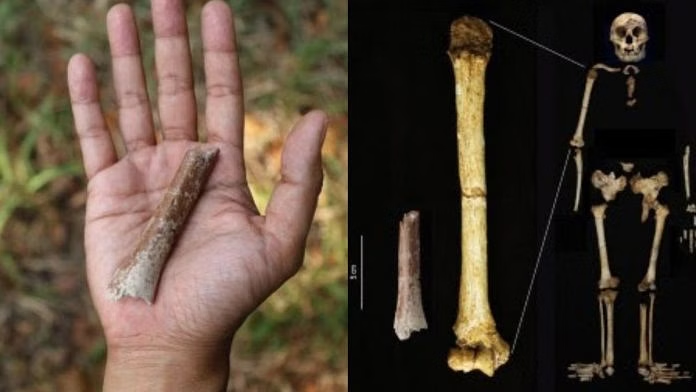Recent excavations on the remote Indonesian island of Flores have unearthed remarkable new evidence of an early human species. Scientists discovered a tiny upper arm bone fragment that suggests these early humans stood at just three feet tall, possibly making them the shortest early humans ever known. This finding adds a fascinating new chapter to the story of Homo floresiensis, a species already recognized for its small stature.
The implications of this discovery are significant, offering insights into human evolution and how isolated environments can shape the development of species.
Background on Homo floresiensis
The Homo floresiensis species was first discovered 20 years ago in the Liang Bua cave on Flores Island. Nicknamed “hobbits” due to their small size, these early humans stood about three and a half feet tall.
They quickly captured the interest of the scientific community and the public alike, as their diminutive size set them apart from other known human ancestors.
The original fossils, dating back approximately 60,000 years, challenged previous understandings of human evolution, particularly how body size could evolve in isolated environments.
New Discovery and Its Significance

The recent discovery, published in the journal Nature Communications, involves an even smaller individual than those found two decades ago. The arm bone fragment, measuring just 88 millimeters, was found at Mata Menge, a site about 72 kilometers from the original Liang Bua cave.
Analysis suggests that this individual stood at around 3.3 feet tall, even shorter than the previously discovered “hobbits.”
This finding is significant because it indicates that the ancestors of Homo floresiensis were even smaller, raising new questions about their evolutionary history.
Evolutionary Implications
The new evidence supports the theory that Homo floresiensis descended from Homo erectus, a larger-bodied species that lived in Indonesia.
Homo erectus, which first appeared around 1.9 million years ago, had body proportions similar to modern humans, though with a smaller brain.
The drastic reduction in size observed in Homo floresiensis is believed to be a result of island dwarfism, a process where species become smaller due to the limited resources available in isolated environments like Flores Island.
According to Professor Adam Brumm of Griffith University, the reduction in body size likely occurred over many generations, possibly between one million and 700,000 years ago.
The smaller body size would have provided advantages in an environment where food was scarce. This evolutionary process resulted in a species that remained small for possibly 600,000 years, a remarkable example of how isolation can shape the development of species.
Ongoing Research and Questions
The discovery of the tiny arm bone has prompted further research into the evolutionary history of Homo floresiensis. One of the key questions scientists are now exploring is why this species remained small while other human ancestors, like Homo sapiens, evolved to have larger bodies and brains.
The findings also raise the possibility that there may have been other, even smaller, individuals within this population, which could further complicate our understanding of human evolution.
Professor Yousuke Kaifu of the University of Tokyo, who was involved in the study, expressed excitement and curiosity about the discovery. He noted that the bone fragment’s small size initially led researchers to believe it belonged to a child, but further analysis confirmed it was from an adult.
This revelation adds another layer of complexity to the study of Homo floresiensis and highlights the need for more research to determine where these individuals fit in the broader human evolutionary story.
Impact of Modern Humans
One of the more sobering aspects of the Homo floresiensis story is their eventual extinction. The species is believed to have disappeared not long after Homo sapiens arrived in the region.
Some researchers, including Professor Brumm, suggest that the arrival of modern humans may have played a role in the extinction of these “hobbits.”
This possibility adds to the growing body of evidence that Homo sapiens had a significant impact on other human species as they spread across the globe.
The recent discovery on Flores Island of an even smaller ancestor of Homo floresiensis offers exciting new insights into human evolution. This finding underscores the uniqueness of the species and the role that isolated environments can play in shaping the development of life.
As scientists continue to study these remains, we may gain a deeper understanding of how early humans adapted to their environments and what led to the survival—or extinction—of different species.
The tiny arm bone fragment serves as a powerful reminder of the diversity and complexity of our evolutionary history.





